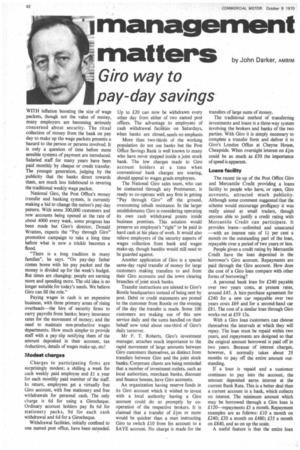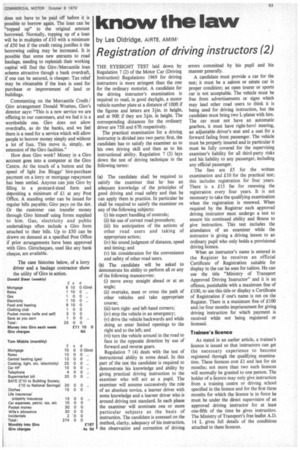management
Page 64

Page 65

If you've noticed an error in this article please click here to report it so we can fix it.
matters by John Darker, AMBIM
Giro way to pay-day savings
WITH inflation boosting the size of wage packets, though not the value of money, many employers are becoming seriously concerned about security. The ritual collection of money from the bank on pay day to make up the wage packets presents a hazard to the person or persons involved. It is only a question of time before more sensible systems of payment are introduced. Salaried staff for many years have been paid monthly by cheque or credit transfer. The younger generation, judging by the publicity that the banks direct towards them, are much less hidebound in revering the traditional weekly wage packet.
National Giro, the Post Office's money transfer and banking system, is currently making a bid to change the nation's pay-day pattern. With some 300,000 customers and new accounts being opened at the rate of about 4000 every week, some progress has been made but Giro's director, Donald Wratten, expects the "Pay through Giro" promotion campaign to take a long time before what is now a trickle becomes a flood.
"There is a long tradition in many families", he says. "On pay-day father comes home with his pay packet and the money is divided up for the week's budget. But times are changing: people are earning more and spending more. The old idea is no longer suitable for today's needs. We believe Giro can fill the role."
Paying wages in cash is an expensive business, with three primary areas of rising overheads—the hire of security firms to carry payrolls from banks; heavy insurance rates for the movement of money; and the need to maintain non-productive wages departments. How much simpler to provide staff with a pay-slip notifying them of the amount deposited in their account, tax deductions, details of wages make-up, etc!
Modest charges
Charges to participating firms are surprisingly modest; a shilling a week for each weekly paid employee and £1 a year for each monthly paid member of the staff. In return, employees get a virtually free Giro account, with free stationery and free withdrawals for personal cash. The only charge is 6d for using a Girocheque. Ordinary account holders pay 8s 6d for stationery packs, 9d for each cash withdrawal and 6d for a Girocheque.
Withdrawal facilities, initially confined to one named post office, have been extended. Up to £20 can now be withdrawn every other day from either of two named post offices. The advantage to employees of cash withdrawal facilities on Saturdays, when banks are closed, needs no emphasis.
More than two-thirds of the working population do not use banks but the Post Office Savings Bank is well known to many who have never stepped inside a joint stock bank. The low charges made to Giro account holders at a time when conventional bank charges are soaring, should appeal to wages grade employees.
The National Giro sales team, who can be contacted through any Postmaster, is ready to co-operate with any firm in getting "Pay through Giro" off the ground, overcoming inbuilt resistance. In the larger establishments Giro is considering operating its own cash withdrawal .points inside business premises. This solution would preserve an employee's "right" to be paid in hard cash at his place of work. It would also relieve employers of the security aspects of wages collection from bank and wages make-up, though bandits would still need to be guarded against.
Another application of Giro is a special same-day rapid transfer of money for large customers making transfers to and from their Giro accounts and the town clearing branches of joint stock banks.
Transfer instructions are telexed to Giro's Bootle headquarters instead of being sent by post. Debit or credit statements are posted to the customer from Bootle on the evening of the day the transfer is made. Some 100 customers are making use of this new service daily and the sums handled on their behalf now total about one-third of Giro's daily turnover.
Mr F. T. Roberts, Giro's investment manager, attaches much importance to the rapid movement of large amounts between Giro customers themselves, as distinct from transfers between Giro and the joint stock banks. Corporate clients are being reminded that a number of investment outlets, such as local authorities, merchant banks, discount and finance houses, have Giro accounts.
An organization having reserve funds in its Giro account which it wished to invest with a local authority having a Giro account could do so promptly by cooperation of the respective brokers. It is claimed that a transfer of £4m or more would be quicker than a man instructing Giro to switch £10 from his account to a SAYE account. No charge is made for the transfers of large sums of money.
The traditional method of transferring investments and loans is a three-way system involving the brokers and banks of the two parties. With Giro it is simply necessary to complete a transfer form and deliver it to Giro's London Office at Cheyne House, Cheapside. When overnight interest on could be as much as £50 the importance of speed is apparent.
Loans facility
The recent tie-up of the Post Office Giro and Mercantile Credit providing a loans facility to people who have, or open, Giro accounts, attracted much publicity. Although some comment suggested that the scheme would encourage profligacy it was really aimed at small traders, though anyone able to justify a credit rating with Mercantile Credit can participate. It provides loans—unlimited and unsecured —with an interest rate of 14per cent a month on the outstanding part of the loan, repayable over a period of two years or less.
People given a credit rating by Mercantile Credit have the loan deposited in the borrower's Giro account. Repayments are paid through the Giro account. How does the cost of a Giro loan compare with other forms of borrowing?
A personal bank loan for £240 payable over two years costs, at present rates, around £45. A hire-purchase agreement for £240 for a new car repayable over two years costs £69 and for a second-hand car £81. The cost of a similar loan through Giro works out at £59 13s.
With a Giro loan customers can choose themselves the intervals at which they will repay. The loan must be repaid within two years, and repayments are designed so that the original amount borrowed is paid off in two years. Because of interest charges, however, it normally takes about 29 months to pay off the entire amount outstanding.
If a loan is repaid and a customer continues to pay into the account, the amount deposited earns interest at the current Bank Rate. This is a better deal than a current account in a bank, which collects no interest. The minimum amount which may be borrowed through a Giro loan is £120—repayments £5 a month. Repayment examples are as follows: £10 a month on £240; £20 a month on £480; £35 a month on £840, and so on up the scale.
A useful feature is that the entire loan does not have to be paid off before it is possible to borrow again. The loan can be "topped up" to the original amount borrowed. Normally, topping up of a loan will be in multiples of £10 with a minimum of £50 but if the credit rating justifies it the borrowing ceiling may be increased. It is possible that some new entrants to road haulage, needing to replenish their working capital will find the Giro /Mercantile loan scheme attractive though a bank overdraft, if one can be secured, is cheaper. Tax relief may be obtainable if the loan is used for purchase or improvement of land or buildings.
Commenting on the Mercantile Credit! Giro arrangement Donald Wratten, Giro's director says: "This is a new service we are offering to our customers, and we feel it is a worthwhile one. Giro does not allow overdrafts, as do the banks, and we feel there is a need for a service which will allow people to borrow money simply and without a lot of fuss. This move is, simply, an extension of the Giro facilities."
How does Giro work? Money in a Giro account goes into a computer at the Giro Centre. At the touch of a button and the speed of light Joe Bloggs' hire-purchase payment on a lorry or mortgage repayment has been settled. Anyone can join Giro by filling in a postcard-sized form and depositing a minimum of £1 at any Post Office. A standing order can be issued for regular bills payable; Giro pays on the dot. Or the customer can transfer money through Giro himself using forms supplied to him. Gas, electricity and public undertakings often include a Giro form attached to their bills. Up to £50 can be drawn on demand at a specified Post Office if prior arrangements have been approved with Giro. Girocheques, used like any bank cheque, are available.








































































































